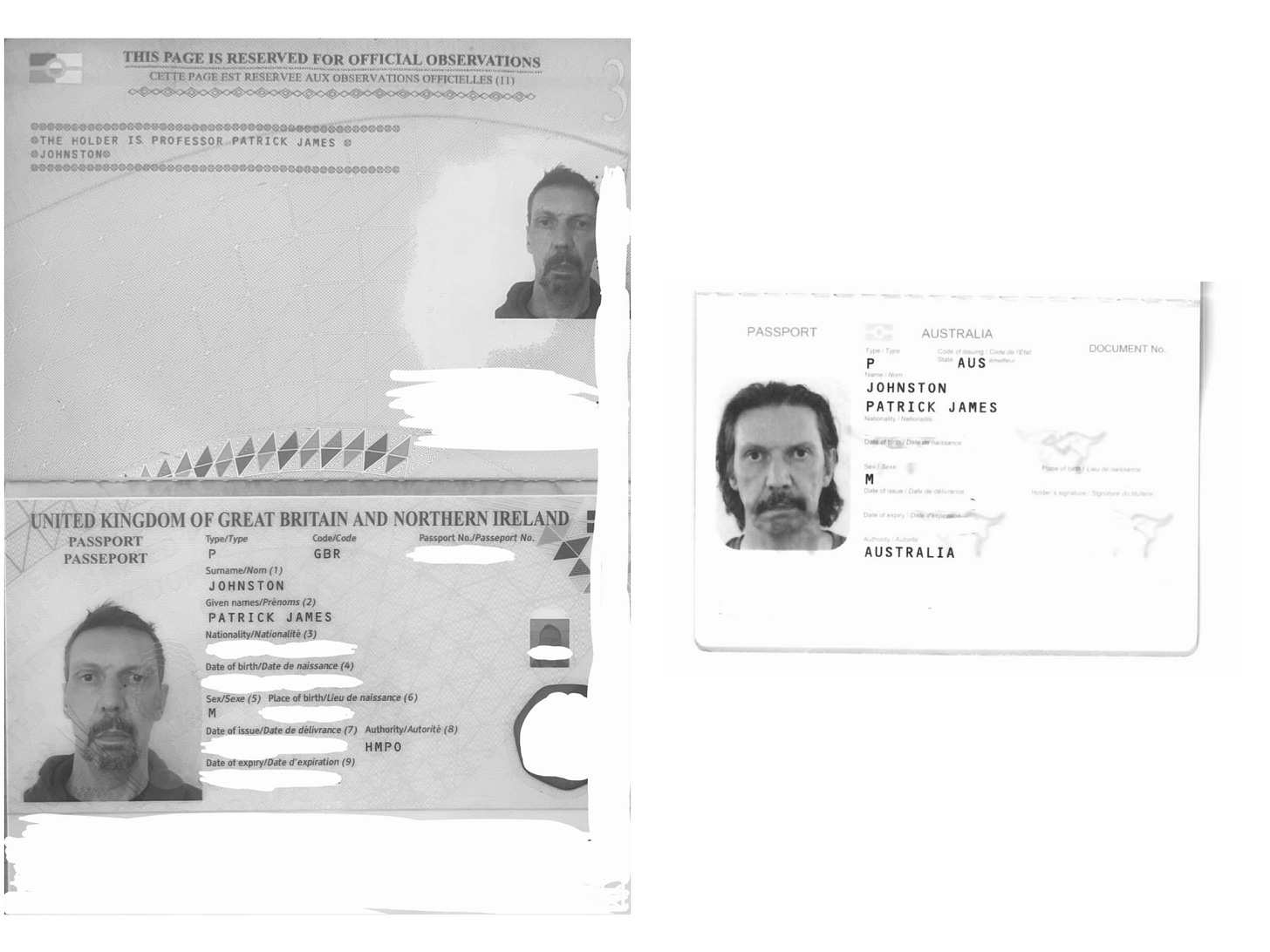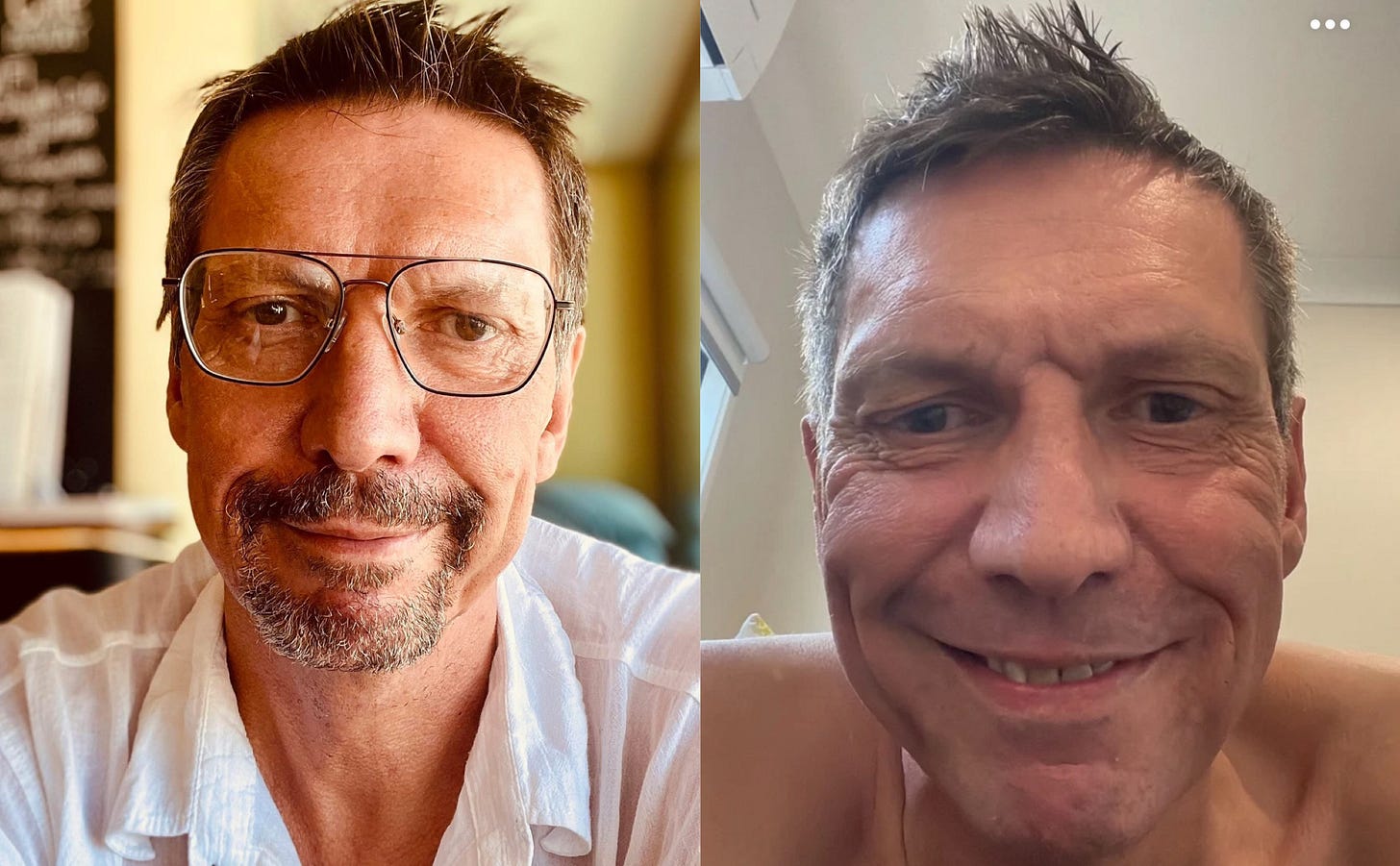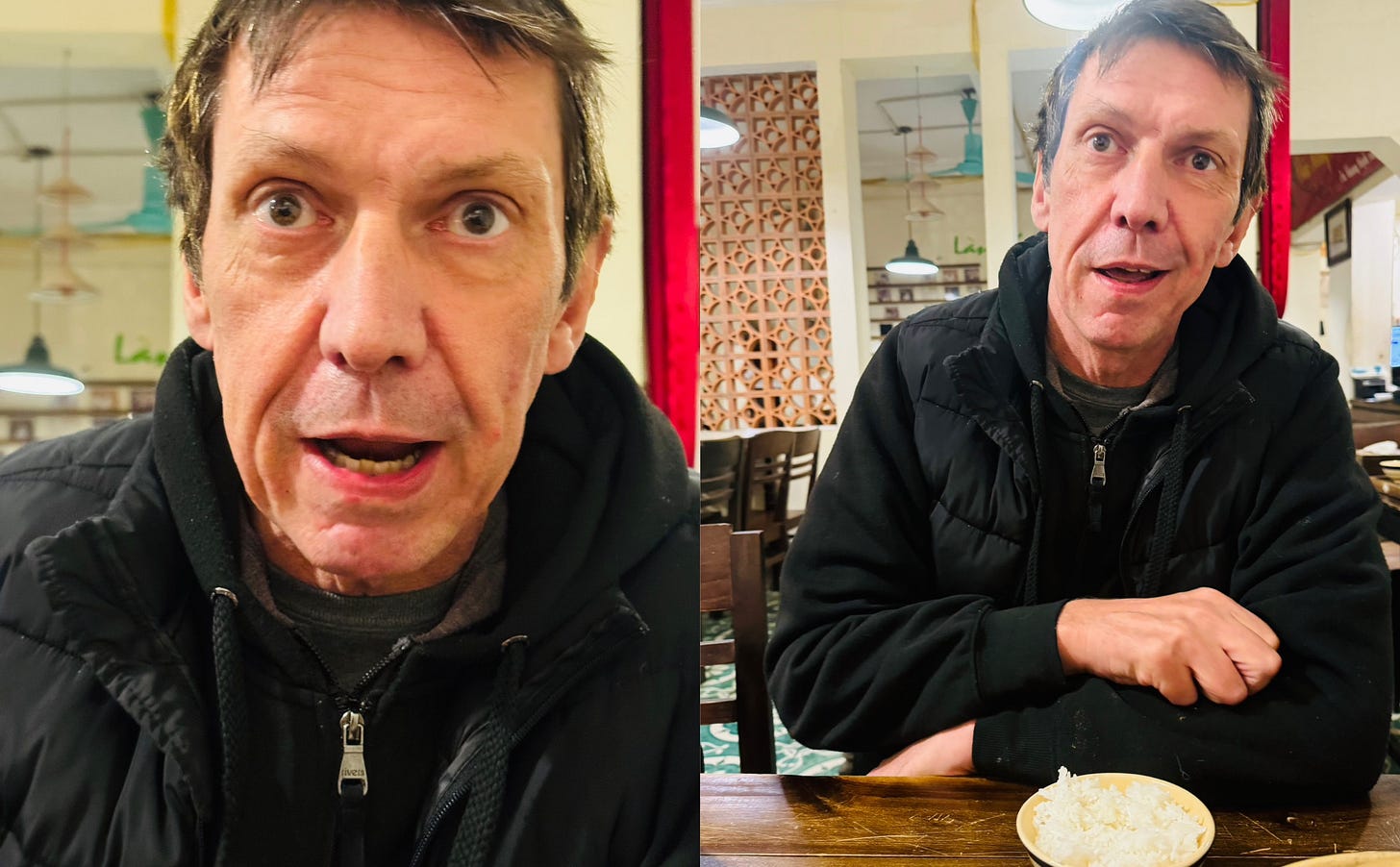Mr. J, a Former Professor Series – Entry 34: Forensic Behavioral-Somatic Report
Forensic Note on Facial Expression (Visual Cue Analysis)
Subject: Patrick James Johnston
Prepared by: Linh Ng — Researcher in Ethics, Media, Policy & Legal Frameworks
Document Type: Somatic Behavior and Neurological Regulation Analysis
Purpose: Behavioral evidence supporting psychological and emotional profiling under cross-sector complaints (legal, academic, and ethics-based).
This image has been redacted to remove all sensitive data. It is used solely for public interest commentary and ethical analysis.
The individual’s facial expression, as captured in the passport image, exhibits traits commonly associated with high-stress rigidity and affective flatness. These include:
Unblinking wide gaze: The eyes appear abnormally widened and fixed, giving an impression of heightened alertness or internal tension. This gaze style is often observed in individuals experiencing hypervigilance or attempting to assert psychological dominance during documentation.
Tightened lips with downward pressure: The lips are sealed and slightly pressed downward, forming an involuntary micro-expression of restraint, denial, or suppressed hostility. It is a common indicator in forensic psychology of someone attempting to control emotional leakage.
Lack of facial asymmetry or natural muscle movement: The absence of spontaneous facial dynamism suggests a highly managed emotional display, sometimes seen in individuals who have developed calculated responses to formal scrutiny (e.g., interrogation, institutional documentation).
While these cues do not constitute proof of guilt or intent, they do align with behavioral patterns noted in psychological profiles involving unresolved confrontation, covert aggression, or performative detachment under legal stress.
I. OBSERVATIONAL SUMMARY
Data source: A sequence of photographic material featuring the subject in various public, semi-private, and digital communication settings.
Environment types:
Cafeteria/public space
Cable car or scenic ride
Digital app environment (dating)
Seated selfie in natural light
Candid gesture involving money handling
This image is part of a publicly available Tinder profile, documented and submitted to QPS & TEQSA in April 2025. Used here solely for public ethics commentary and digital manipulation analysis.
Photograph taken by author in February 2025, in public setting. Used here solely for public ethics commentary and digital manipulation analysis.
Photograph taken by author in November 2024, in public setting. Used here solely for public ethics commentary and digital manipulation analysis.
II. SOMATIC INDICATORS & INTERPRETATION
Face
Observed Behavior: Lack of congruence between eye and mouth expression (e.g., stiff smile, widened but unfocused eyes)
Somatic Interpretation: Indicative of emotional masking and possible dysregulation between affect and self-presentation; aligns with polyvagal hyperarousal or threat vigilance
Eyes
Observed Behavior: Slight retraction of upper eyelid, inconsistent gaze
Somatic Interpretation: Reflects hyper-alertness, typically seen in individuals engaged in social-performance states or compensating for insecurity
Hands & Arm
Observed Behavior: One photo shows both hands obscuring midsection while interacting with a wallet
Somatic Interpretation: A self-soothing or territorial protection gesture, possibly unconscious, linked to insecurity around financial exposure or status assertion
Jaw/Mouth
Observed Behavior: Mild clenching across photos; mouth often slightly ajar or tense
Somatic Interpretation: Reflects underlying psychological strain; consistent with cognitive-emotional dissonance
Shoulders & Spine
Observed Behavior: Shoulders held rigid or slightly hunched; postures often defensive or non-relaxed
Somatic Interpretation: Suggests chronic sympathetic activation, commonly observed in individuals under prolonged self-image management pressure
III. BEHAVIORAL CONVERGENCE: PATTERNS OF STRATEGIC SELF-PRESENTATION
The subject exhibits a persistent pattern of image control under social pressure, including:
Curated smiles and camera angles
Attempts to display resources (e.g., visible wallet and physical gestures)
Overuse of formal posture even in casual settings
These align with neuropsychological strategies of dominance-display mixed with anxiety-compensation, frequently seen in individuals who:
Fear public humiliation or social status loss
Have been previously destabilized in reputational terms
Exhibit markers of narcissistic coping (without implying a disorder)
IV. INTERPRETIVE INSIGHT: SOMATIC–COGNITIVE INCONGRUENCE
The gap between the subject’s bodily language and their intended persona (smile, posture, context) reflects disintegrated self-presentation — a state often linked to:
Chronic internalized performance anxiety
Subconscious threat perception (even in non-threatening environments)
An unstable relationship with emotional self-regulation and external validation
V. CONCLUSION
The observed behavioral somatic patterns suggest that the subject is likely operating from a chronic vigilance state, with bodily defense mechanisms overriding authentic emotional expression. These indicators may correlate with:
High need for control
Avoidant emotional processing
Psychological rigidity under image threat
Such profiles warrant caution in any relational, academic, or organizational setting that involves power dynamics, emotional manipulation, or disputes over credibility and intention.
Disclaimer
This report is non-diagnostic and intended solely for behavioral analysis in ethical, academic, or legal correspondence. It does not replace clinical psychiatric or neurological evaluation but may support narrative and evidentiary framing in investigative contexts.
Note on Naming:
The subject of these verses is identified by name due to the severity of the public threats made during that period.
Naming is not intended to humiliate, but to preserve the integrity of the record and reflect the seriousness of the documented behavior.
While the individual has since responded publicly, the response has not addressed the core evidence. In such cases, visibility remains necessary. Selective rebuttal is not accountability.
Full evidence archive submitted to QPS, TEQSA, AHRC, and Ethics Australia: View here.
Read the full series
- Entry 1: The Man Who Taught Me Ethics by Failing All of Them
- Entry 2: The Disappearance of the Public Poet
- Entry 3: The Hanging Tree Case Study
- Entry 4: Hidden Like Accountability
- Entry 5: The Collapse of Assumptions
- Entry 6: The Ethics of a Tinder Bio
- Entry 7: How He Ate Told Me Everything
- Entry 8: What Makes a Scholar Dangerous
- Entry 9: Fragment of Life, Fragment of Accountability
- Entry 10: Anatomy of Disappointment
- Entry 11: Legal Defense Challenges: A Framing Statement
- Entry 12: Six Years After Ronell – What Academia Still Doesn’t Get
- Entry 13: QUT and The Man Who Raped Me
- Entry 14: Why Sarcasm Toward Institutions Can Backfire
- Entry 15: P*ssy or Toxic Masculinity?
- Entry 16: Who is Your Favorite Comedian?
- Entry 17: And What is Your Favorite Song?
- Entry 18: Grant Proposal — Narrative Ethics as Survivor-Led Forensics
- Entry 19: The Coward Behind the Clone
- Entry 20: [URGENT HIRE] CRISIS COMMUNICATIONS SPECIALIST
- Entry 21: [URGENT] Legal Counsel Needed for Complex Reputation Rehabilitation
- Entry 22: YOU’RE AN ABUSER. STOP CONTACTING ME
- Entry 23: Seeking Counsel for a Fallen Academic
- Entry 24: Internal Legal-PR Briefing
- Entry 25: For Journalists – Legal & Ethical Clearance Summary
- Entry 29: Forensic Commentary on “LARGE Language Muddle”
- Entry 30: Don’t Just Threaten My Future. Because I’m Going To Archive Your Present
- Entry 31: Open Letter to the Person Who Tried to Break Me with Defamation
- Entry 32: Defamation, Harassment, Doxxing Class 101
- Entry 33: Confidential Crisis Recovery Proposal
- Entry 34: Forensic Behavioral-Somatic Report (you are here)
- Entry 35: Forensic Commentary on the Tattoos
- Entry 36: QUT and the Abuser They Once Had
- Entry 38: When Poetry Becomes Revenge Porn
- Entry 40: A Man Built for Applause, Not Accountability
- Entry 41: Neurobehavioral Addendum
- Entry 43: Why Does It Sound Like a War Metaphor?
- Entry 44: Forensic Commentary on Racialized and Fetishizing Language in “Hidden Like Rice”
- Entry 45: Public Misuse of Former Academic Affiliation
- Entry 46: The Two Things That Didn’t Leave a Bad Impression
- Entry 47: When Affection is Just an Alibi (A Bundy-Inspired Reflection)
- Entry 48: Humbert, Lolita, and the Fetish of Fragility
- Entry 49: The Fetish of Smallness as Symbolic Violence
- Entry 50: Motif Risk Analysis
- Entry 52: Can an Abuser Be a Good Father?
- Entry 53: Who Protects the Children?
- Entry 54: From Blackmail to Children
- Entry 55: A Letter I’ll Never Send
- Entry 56: Outc(L)assed - Critical Race Analysis
- Entry 57: Forensic Breakdown: “A Voidance” by Johnston
- Entry 58: Johnston, Who Raised You?
- Entry 59: Public Financial Terms & Narrative Conditions
- Entry 60: What Kind of Future Do You Think Awaits You?
- Entry 61: Why I Believe He Has No Real PR or Legal Team
- Entry 62: Why I Can Legally (and Ethically) Call You a Pathetic Pig
- Entry 63: Tell Me You’re a Pathetic Pig Without Telling Me You’re a Pathetic Pig
- Entry 65: Did Your Mother Teach You To Speak Like This?
- Entry 66: Nobody Cares Anyway
- Reflection: The Miscalculation
(More entries coming soon)
→ [Back to Start: Introducing Mr. J, a Former Professor Series]
© 2025 Linh Ng. All rights reserved.
This publication is intended for educational and reflective purposes only.
Sharing the original link is welcomed and encouraged.
Please do not reproduce, redistribute, or translate this content — in whole or in part — without written permission.
This piece reflects both lived experience and critical analysis. It is not meant to be detached from its author or reframed without context.
Misuse or decontextualization may lead to formal clarification or takedown requests.
This work has been reviewed and quietly followed by scholars, educators, and ethics professionals across multiple sectors.
If your institution is engaging in critical discourse around narrative justice, symbolic coercion, or representational ethics, feel free to connect via Substack DMs or formal channels.
A regulatory case regarding this matter has already been classified under a protected status within national education integrity systems.
Should any reputational countermeasures or distortions arise, I reserve the right to publish the documented timeline, behavioral patterns, and contextual metadata.
All relevant documentation has been submitted through formal legal and regulatory pathways.







